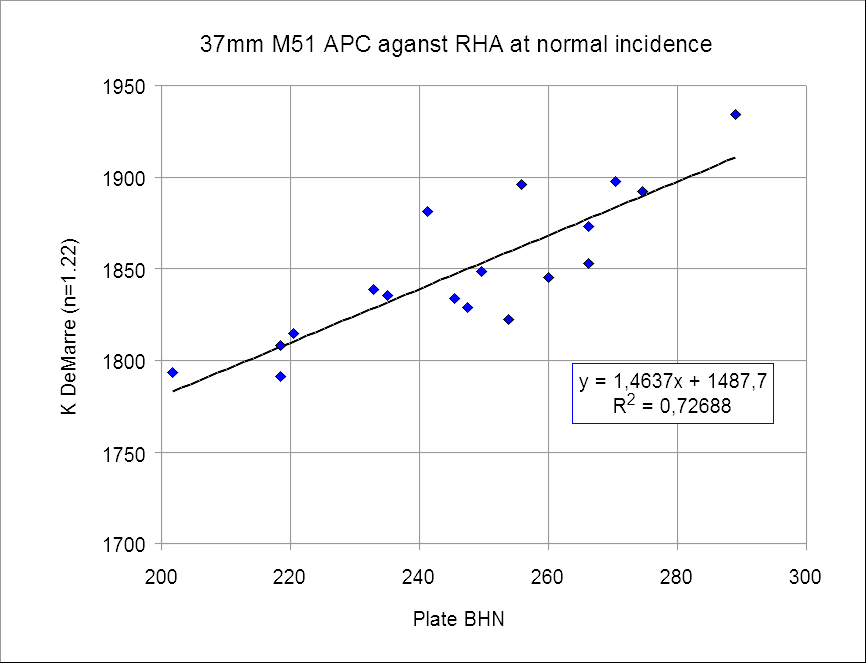I mean, that’s not surprising. This method is not supposed to change the results given by de Marre formula by a lot. Changing the ballistic limit by +3% at most will change penetration by only +4.3%

The discrepancy that you see here is not a random fluke, I’ve seen it before. The ballistic limit in the DeMarre formula is assumed to be proportional to the 0.7-th power of T/D ratio, not the ~0.62 seen here.
But this is not an error in the formula, it is a deliberate choice.
The armor plates used in these tests are all about the same tensile strength / hardness (the two are approximately directly proportional), while the nominal BHN of armor plates manufactured for real vehicles decreases as their thickness grows. Because of this the data points for such armour would move a bit downwards in the lower T/D range and would make the overall trend be steeper and therefore the required exponent would be higher than 0.62.

Beyond 150mm thickness the tensile strength of german penetration testing plate is constant and using DeMarre-like formula in this region requires appropriate adjustments.
What are we looking at?
Are those penetration estimates or test data?
So Y axis is K factor? What’s this n=1.22?
Also whats the conclusion?
I’m guessing the line represents the dependency of K factor to the armor hardness for more accurate penetration estimations, in the case of 37mm APC?
Yes, this is experimental data. Source for this graph is the same as last one. The line is a linear trend model fitted through the data set using the “least squares” method.
The point is to have solid evidence, and not just intuition, that the K constant can take different values, with neither being the correct of wrong one.
Hello, I will link this topic here as it is related!
It’s about low-caliber HVAP/APDS, and how Gaijin’s calculator doesn’t match the sources:
Yeah adding ballistic limits would be so nice, instead of all rounds just penetrating impossible amounts of armor at higher velocity.
But I feel like that is never going to happn with WT.
I mean you know:
- RoF is a balance factor
- Everything can be repaired etc.
Huh? I think we are talking about different things. Yes, the high velocity guns do currently somewhat overperform in this game, but that’s not what “ballistic limit” means. It’s just another way to indicate the limit velocity for perforation.
I don’t get what this graph is showing.
The y axis is the ratio of 30 degree ballistic limits to 0 degree ballistic limits. The x axis is the thickness to caliber ratio.
A plate that is .5 times diameter will have a 30 degree ballistic limit that is the same as its 0 degree ballistic limit. A plate that is 1.0 times diameter will have a 30 degree ballistic limit that is 1.125 times its 0 degree ballistic limit.
Oh, I see.
Well in game that’s taken care of using slope effects, rather than the calculator itself.
I haven’t done much research on HE shells, so you can make a suggestion if you want. I want to keep this one to kinetic AP rounds for now.
I’m not sure. I don’t know if I’ve ever seen documents showing armor penetration for HE shells.
It already is applied to HE rounds.
However they use a modified version that gives much lower kinetic penetration values.
That’s why stuff like US 90 mm HE rounds have penetration drop off with range and angle, until the kinetic penetration falls below the chemical explosive penetration at which point the penetration remains constant.
Larger HE rounds have high enough chemical penetration to where the kinetic penetration never shows in the stat card (like the russian 122 mm).
I have seen a British, American and russian source with 1200m/s with a lighter 885g Shell How much Pen would that have? I suppose thats a “Late” variant of Pzgr.40
Im not shure if i 100% understood this correct, but would that more or less simply mean a buff to uncapped, non filler and APCR rounds?
Would against flat armor be the 5 cm Pzgr. be better than the 5 cm Pzgr.39?
The lighter round would be about 173mm.
Yes, at least at closer ranges. The AP and APC both have the same overall weight but the APC loses the cap weight during penetration.
The AP would pen around 86mm while the APC would pen around 80mm.
The L/60?

